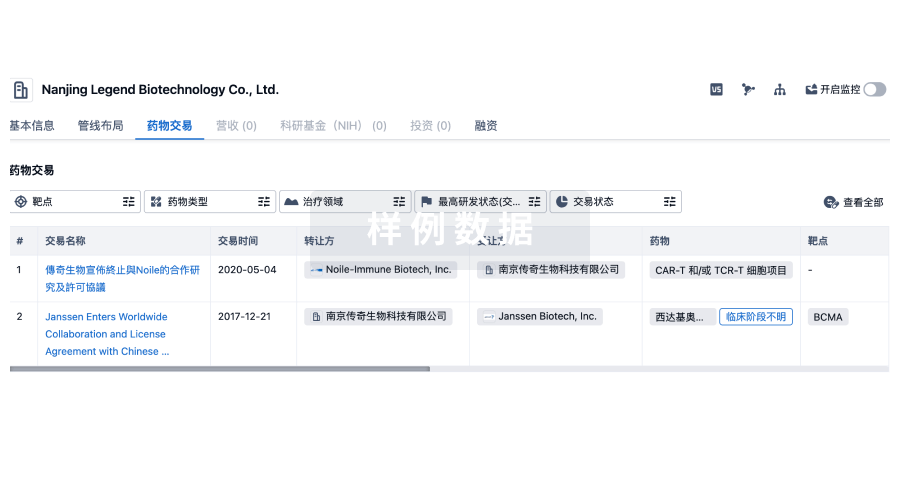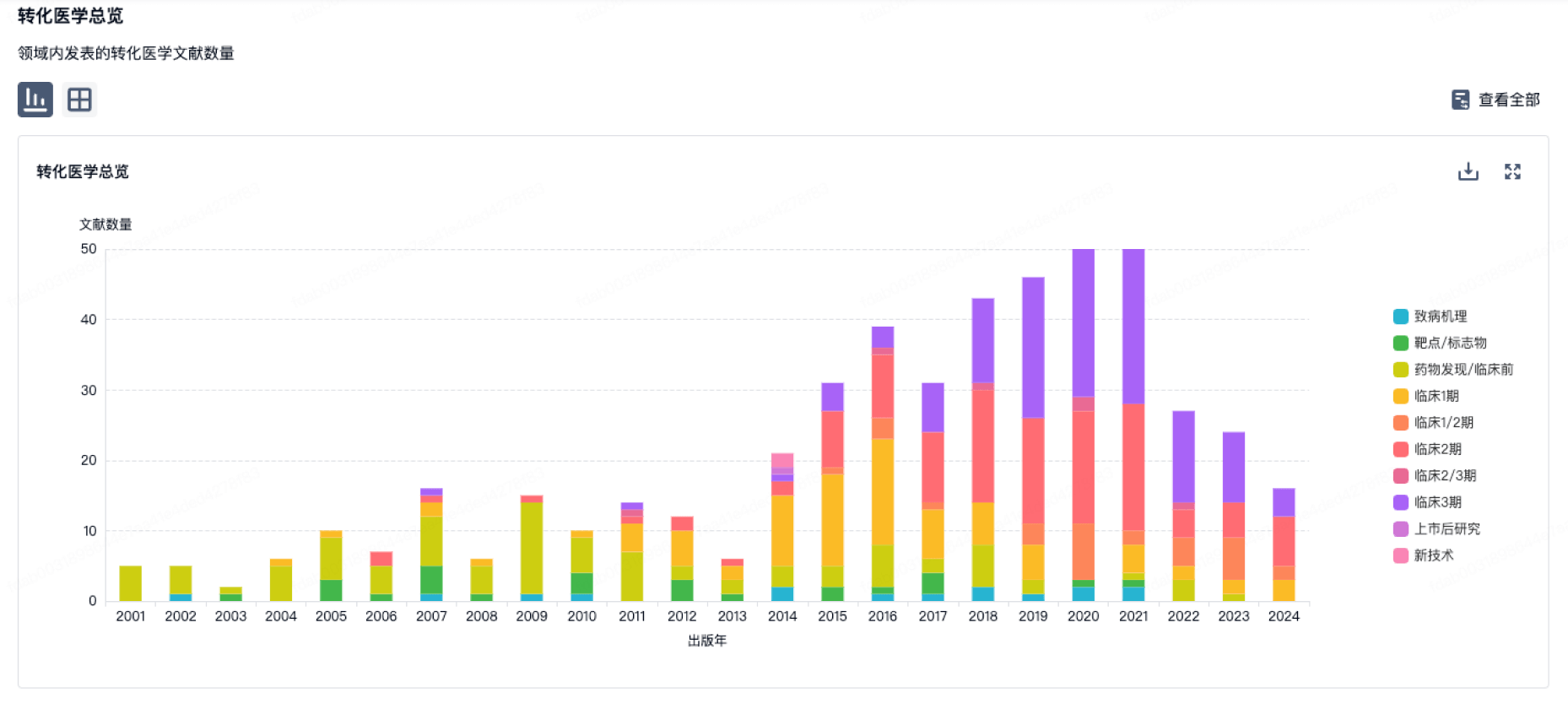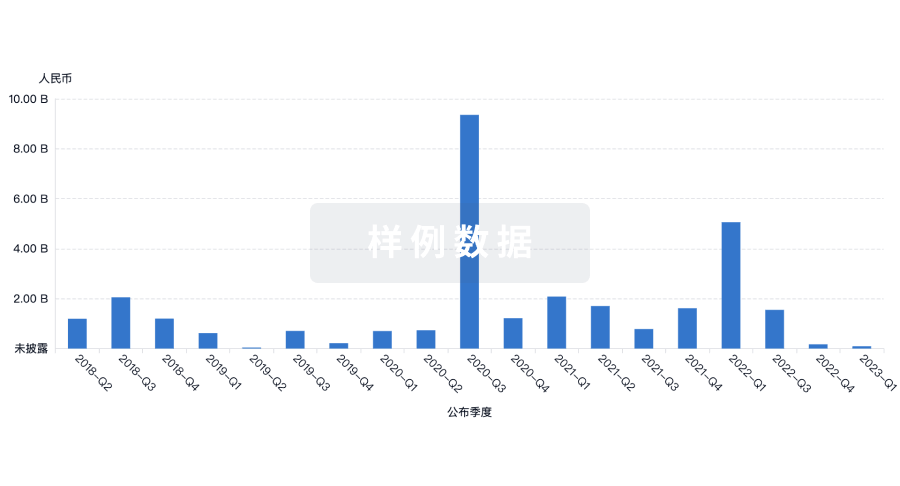预约演示
更新于:2025-10-30

University of Glasgow
更新于:2025-10-30
概览
标签
肿瘤
消化系统疾病
其他疾病
小分子化药
蛋白水解靶向嵌合体(PROTAC)
蛋白类药物
疾病领域得分
一眼洞穿机构专注的疾病领域
暂无数据
技术平台
公司药物应用最多的技术
暂无数据
靶点
公司最常开发的靶点
暂无数据
| 排名前五的药物类型 | 数量 |
|---|---|
| 小分子化药 | 6 |
| 合成多肽 | 1 |
| 蛋白水解靶向嵌合体(PROTAC) | 1 |
| 蛋白类药物 | 1 |
关联
9
项与 University of Glasgow 相关的药物靶点 |
作用机制 CDC34 modulators |
在研机构 |
原研机构 |
在研适应症- |
非在研适应症- |
最高研发阶段临床前 |
首次获批国家/地区- |
首次获批日期- |
靶点 |
作用机制 CRAF抑制剂 |
在研适应症 |
非在研适应症- |
最高研发阶段临床前 |
首次获批国家/地区- |
首次获批日期- |
靶点- |
作用机制- |
在研适应症 |
非在研适应症- |
最高研发阶段临床前 |
首次获批国家/地区- |
首次获批日期- |
424
项与 University of Glasgow 相关的临床试验NCT07048184
Sarcoma Surgery Wound Complications Comparing Usual Versus Negative Pressure Dressing: a Randomised Phase II Trial
To compare the differences in clinical outcomes and health economics between standard absorbent dressings versus Negative Pressure Wound Therapy dressings following the surgical resection of sarcoma tumours.
开始日期2025-12-01 |
申办/合作机构 |
NCT07208188
Transcutaneous Spinal Cord Stimulation for Rehabilitation of Upper Limbs in Early Spinal Cord Injury: Randomised Feasibility Study
Regaining hand and arm function is an important step towards regaining independence following high-level spinal cord injury (tetraplegia). The delivery of small electrical pulses over the skin above the spinal cord, called transcutaneous spinal cord stimulation (tESCS), appears to improve the arm and hand function of people who have had tetraplegia for several years when delivered at the same time as upper limb therapy. However, tESCS has not been tested in people who have a new spinal cord injury. It should be straightforward to deliver tESCS during standard upper limb therapy sessions to inpatients receiving primary rehabilitation. The investigators want to test the practical aspects of delivering this intervention and also to compare recovery between a group of people who only receive upper limb therapy and a group who receive upper limb therapy and tESCS. If successful, tESCS could in the future be used as part of regular therapy following an acute spinal cord injury. Benefits could include faster and better recovery, reduced stay in hospital, and reduced NHS costs.
开始日期2025-11-01 |
申办/合作机构 |
NCT07189689
Mental Health Mission Mood Disorder Cohort Study
The current study aims to understand why some people with depression respond to treatment and others do not, using markers of clinical symptoms, both clinician reported outcome measures and patient reported outcome measures, demographic information, cognitive function, genetic sequence information (genomic), chemical measures of metabolism (metabolomic), protein makeup (proteomic) and the body's natural defence system (immune/inflammatory markers) together with collections of cells that will facilitate new research to drive improvements in diagnosis and treatment of mood disorders that may be proving difficult to treat. This will allow future clinical trials within the NHS, academia and industry to drive forward new approaches and treatments.
Participants who provide consent for re-contact for future treatment trials and other research studies have the potential to benefit from this with participation in experimental studies and clinical trials associated with improved patient outcomes. Overall, the cohort will generally support greater access to research opportunities for a wider population of people.
Participants who provide consent for re-contact for future treatment trials and other research studies have the potential to benefit from this with participation in experimental studies and clinical trials associated with improved patient outcomes. Overall, the cohort will generally support greater access to research opportunities for a wider population of people.
开始日期2025-10-01 |
申办/合作机构  University of Oxford University of Oxford [+21] |
100 项与 University of Glasgow 相关的临床结果
登录后查看更多信息
0 项与 University of Glasgow 相关的专利(医药)
登录后查看更多信息
55,969
项与 University of Glasgow 相关的文献(医药)2026-02-01·BIOMATERIALS
Tenascin-c functionalised self-assembling peptide hydrogels for critical-sized bone defect reconstruction
Article
作者: Dong, Siyuan ; Salmeron-Sanchez, Manuel ; Miller, Aline F ; Pringle, Eonan W ; Saiani, Alberto ; Windmill, James F C ; Williams, Jonathan A ; Trubert-Paneli, Alexandre ; Iturriaga, Leire ; Rogkoti, Theodora ; Gonzalez-Garcia, Cristina ; Cipitria, Amaia
Critical-sized bone defects cannot heal spontaneously and receive poor clinical prognosis due to limitations in modern treatment strategies. Next-generation therapies are applying biomaterials incorporating BMP-2 to effectively promote and support bone regeneration, but adverse effects are linked to uncontrolled BMP-2 egress from the biomaterial. Implementing extracellular matrix proteins to biomaterials is a favourable approach to alleviate these drawbacks, and self-assembling peptide hydrogels are rapidly emerging as modulable and versatile biomaterials. Here, we describe the creation of a tenascin-c-functionalised peptide hydrogel designed to regenerate critical-sized bone defects. A recombinant fragment of tenascin-c spanning from the 3rd to 5th fibronectin-like domains is integrated into the fibre network. We demonstrate that this nascent construct effectively retains BMP-2 to differentiate mesenchymal stem cells into mature osteoblasts and achieves complete unionisation of murine critical-sized bone defects under low BMP-2 dose. All in all, we demonstrate tenascin-c as a suitable candidate to functionalise biomaterials intended for bone engineering applications and the promising potential of self-assembling peptide hydrogels in treating critical-sized bone defects.
2026-02-01·JOURNAL OF COLLOID AND INTERFACE SCIENCE
Regulating interfacial water structure to suppress vanadium dissolution in aqueous zinc-ion batteries
Article
作者: Zhang, Heng ; Zheng, Chaohe ; Zheng, Qiaoji ; He, Xuemei ; Li, Xiaoying ; Xie, Min ; Tan, Xin ; Lam, Kwok-Ho ; Lin, Dunmin
Vanadium-based cathodes in aqueous zinc-ion batteries (AZIBs) suffer from severe capacity fading due to their high solubility in weakly acidic zinc salt electrolytes. In this work, we propose a novel electrolyte formulation by introducing tetrahydrofurfuryl alcohol (THFA) as an additive to a 2 M zinc trifluoromethanesulfonate (Zn(OTf)2) solution to effectively suppress the dissolution of V6O13·nH2O (VOH) cathodes. THFA preferentially adsorbs onto the cathode surface, displacing interfacial water and mitigating water-induced degradation of VO bonds. Simultaneously, the strong interaction between THFA and Zn2+ alters the solvation structure, reducing the population of active water molecules coordinated to Zn2+ ions. These synergistic effects significantly inhibit vanadium dissolution and enhance interfacial stability. Benefiting from this interfacial engineering strategy, the VOH cathode delivers a high specific capacity of 477.7 mAh g-1 at 0.5 A g-1 and achieves excellent capacity retention of 82.6 % after 200 cycles, in stark contrast to 45.9 % for the additive-free system. Moreover, long-term cycling tests demonstrate outstanding durability, with 71.4 % capacity retention after 10,000 cycles at 10 A g-1, compared to only 37.5 % without the additive. This study offers a promising approach to mitigate cathode dissolution via electrolyte design and provides a generalizable strategy for improving the cycling stability of vanadium-based AZIBs.
2026-01-01·APPLIED ERGONOMICS
COVID-19 vaccination systems: Human Factors at the ‘sharp end’
Article
作者: Hignett, Sue ; Bowie, Paul ; Vosper, Helen ; Edmonds, Janette ; Currie, Hugh
PURPOSE:
To share key learnings from the assessment of a COVID-19 vaccination system in Scotland using a Human Reliability Analysis (HRA) approach.
METHOD:
Project data were collected in February 2021 in NHS Ayrshire and Arran (NHSAA) - the regional health authority - using document analysis (Service Delivery Manual, 2020), observations (2 site visits), and workshops (n = 8, with 26 participants). The Systematic Human Error Reduction and Prediction Approach (SHERPA) is a framework for human reliability analysis that can be used as part of a safety assessment or safety case to determine whether the system is 'safe enough' and provide recommendations to improve safety by mitigating error potential. In this paper it was used to assess the service delivery system and make recommendations.
RESULTS:
Many recovery mechanisms and risk control measures had already been implemented by NHSAA. Eighteen issues required additional risk control, grouped into three themes.
CONCLUSION:
The findings were used to improve the current service delivery and provide guidance for the safe design and delivery of future rollouts of time-critical public health vaccination programmes.
177
项与 University of Glasgow 相关的新闻(医药)2025-10-30
习近平谈人工智能:赢得全球科技竞争主动权的重要战略抓手
定了!北京又一所985,去雄安!
刚刚!美国政府制裁中国科技大学等37家实体
央企首次发布!材料领域“十大基础科学问题”
第一性原理计算解决50年悬而未决难题:半导体中铜为何扩散更快?
Ab initio及第一性原理入门参考书介绍
985博导亲测:用DeepSeek写国自然本子,3天完成30天工作量
Nature:博士太多,高校已经装不下了!
我的博士生已经半个月没主动联系我了, 不知道他是不是在做科研, 怎么能让他更主动一点?
固体物理与DFT模拟【4】:好书推荐——谢希德、陆栋《固体能带理论》
来自公众号:ScienceAI
本文以传播知识为目的,如有侵权请后台联系我们,我们将在第一时间删除。
编辑丨&
在一张桌前有两个人,倘若我们能读懂他们的语言神态,那我们就能推断出下一刻他们会是争吵亦或是握手。
现在,把「人」换成蛋白质,把「话」换成氨基酸序列——蛋白质相互作用是生命过程的核心:信号传导、代谢通路、病毒入侵宿主等,都依赖特定蛋白质之间的物理接触。倘若能读懂其中的相互作用,也就能为接下来的一系列研究铺平道路。
为此,格拉斯哥大学(University of Glasgow)等的研究者提出一种方法,填补现有模型在泛化能力上的缺陷。他们把单蛋白的语言模型扩展为双蛋白的「对话识别器」,让大型蛋白质语言模型学会同时听两条序列,从中判断它们是否会相互作用(PPI)。
相关的研究以「PLM-interact: extending protein language models to predict protein-protein interactions」为题,于 2025 年 10 月 27 日发布在《Nature Communications》。
论文链接:https://www.nature.com/articles/s41467-025-64512-w
一款对接翻译器
在病毒学中,PPIs 尤其重要,因为病毒完全依赖于宿主细胞进行复制,主要通过与宿主蛋白质的特异性相互作用来实现。倘若是能读懂其中的相互作用,就能为开发针对性治疗药物带来更便捷的方法。
计算算法为大规模预测 PPI 提供了一种高效的替代方案。基于大型公共蛋白质序列数据库训练的蛋白质语言模型(PLM)被用于编码序列组成、进化和结构特征,成为表示蛋白质在最新 PPI 预测器中的首选方法。
而该研究团队所提出的 PLM-Interact,通过扩展和微调预训练的 PLM,即 ESM-2,直接建模 PPI。它能把两条蛋白序列拼接入模型,使 Transformer 的注意力能跨蛋白捕捉「配对」信息,而不是先各自编码再拼特征。
图 1:PLM-interact 与现有 PPI 预测架构的比较。
在掩码语言建模(MLM)任务之外,团队加入二元分类任务,直接训练模型判断给定的蛋白对是否真实交互。分类损失与 MLM 损失按一定比例(paper 中选择 1:10)混合训练,且模型层被全部微调以适配这一双序列任务。
这些设计让氨基酸残基间的跨蛋白注意力成为可能:模型不再只学习「单句语法」,而能学习两条序列间的「对话格局」。该方法既保留了预训练的结构-进化信息,又把相互作用信号嵌入到语言模型内部。
跨物种提升
为了检验 PLM-interact 的性能,该模型在包含 421,792 对蛋白的训练集(以人类数据为主)进行训练,并与其余六种方法在物种其他物种上进行测试。
相较于六种现有方法,PLM-interact 在 AUPR(精确率-召回曲线下面积)上取得了最佳成绩:在鼠、果蝇和线虫上分别提升约 2%、8%、6%(对比次优方法),在进化上更远的酵母和细菌上也有显著增益。
图 2:PLM-interact 与最先进的 PPI 预测模型的基准测试结果。
PLM-interact 的改进归因于其正确识别正 PPI 的能力:它始终将更高的相互作用概率分配给真正的阳性 PPI。相比之下,其他方法在所有保留物种中都给出了较低的相互作用概率估计。
PLM-interact 能够准确预测五个关键的蛋白质相互作用,这些相互作用控制着重要的生物学功能,包括 RNA 聚合和蛋白质运输。值得注意的是,其他蛋白质 AI 工具,包括由谷歌 DeepMind 支持的 AlphaFold3,只能预测五个蛋白质相互作用中的一个。
图 3:PLM-interact 正确预测但 TUnA 和 TT3D 未能预测的每个物种的 PPI 示例。
那么,为什么这些举措有用?
把两条序列放进同一个 Transformer,等于是把「对话」上下文纳入模型的注意力机制:模型可以直接把一个蛋白的某个残基与另一个蛋白的某个残基联系起来,形成「跨分子接触」的隐式表示。这比先各自编码再拼接特征更直接,也更容易捕捉到互作所需的互补性。
把分子当语言来读
PLM-interact 展示了一个清晰的理念:把序列看成「句子」,把相互作用看成「对话」,通过模型学习语言级别的跨分子关系,也可以在未见物种上实现高度泛化。
在超过 6.5 亿个独立参数的独立参数的背后,是研究者对开发一个能够以前所未有的规模和精度的,预测蛋白质相互作用的系统所作出的贡献。这项工作是「让超级计算机学会分子语言」的一步,把序列信息转化为可以操作的生物学推断。
相关报道:
https://phys.org/news/2025-10-supercomputer-ai-intricate-language-biomolecules.html
2025-10-29
·智药邦
2025年10月,融合化学、机器人技术、计算科学及Chemputation(Chemify专为分子创造数字化打造的人工智能技术)为一体的深度科技先锋企业Chemify宣布,通过B轮融资筹集超5000万美元。
此前融资参见实现化学数字化|Chemify宣布完成4300万美元A轮融资
此轮超额认购的融资由Wing Venture Capital与Insight Partners联合领投,8VC等顶级投资机构及老股东Triatomic Capital、Blueyard、Rockspring、Eos共同参与。
创始人兼首席执行官Lee Cronin表示:"Chemify致力于成为全球化学领域的数字化基石,推动快速设计与发现。我们的愿景是让Chemify能够按需设计制造涵盖药物研发、新型催化剂及电子材料等全化学领域的任何分子。下一步发展将引领化学发现与制造的数字化自动化革命。"
今年初,Chemify启用全球首个Chemifarm——专为分子设计与合成建造的全自动化工厂,目标成为世界最尖端实验室。Chemifarm核心整合了可扩展编程语言Chemputation平台、先进机器人系统及全球最大的验证反应数据库,为曾被视作不可企及的分子创造出数据驱动的快速合成新路径。B轮融资将助力Chemify在全球复制这一蓝图,建设数字化化学中心网络,为全球制药、生物技术和材料科学合作伙伴提供按需分子设计与制造服务。
Chemify计划由首席技术官Mike Bell牵头建立硅谷实验基地,该扩展将显著提升按需分子设计、优化与合成能力,大幅压缩从概念到化合物的研发周期。公司旨在引领变革性药物与新一代材料发现的同时,建立小分子开发制造的新全球标准。
Wing Venture Capital合伙人Ansuman Satpathy评价:"Chemify技术通过自动化与实体化AI实现化学数字化,将化学合成从艺术转变为可编程科学。我们期待支持团队助力科学家以前所未有的效率与精准度创造新型分子,其成果将推动药物研发与医学领域的重大突破。"
Insight Partners副总裁Aiden Aceves指出:"Lee是位逆风而行的叛逆者。Chemify利用AI确保复杂分子可合成性的能力彻底改变了当今药物化学模式,公司愿景与其在早期医药合作中的优异成果交相辉映。"
伴随本轮融资,Wing Venture Capital的Ansuman Satpathy与Insight Partners的Aiden Aceves已加入Chemify董事会。
Chemify于2022年从格拉斯哥大学分拆创立,以数字化根基重塑化学,融合自动化、AI与数据加速新药及先进材料发现,同时构建可扩展的全球分子创新平台。
关于Chemify
Chemify通过Chemputation技术(融合机器人学与人工智能)将数字代码转化为实体化合物,重塑药物与先进材料的新型分子发现与合成路径。公司总部位于苏格兰格拉斯哥,由Lee Cronin创立,旨在为人类福祉实现全球化化学数字化。了解更多请访问Chemify.io。
参考资料:
https://www.businesswire.com/news/home/20251021496528/en/Chemify-Raises-More-Than-%2450-Million-in-Oversubscribed-Series-B-to-Drive-Global-Expansion-of-Digital-Chemistry-and-Discovery
--------- End ---------
感兴趣的读者,可以添加小邦微信加入读者实名讨论微信群。添加时请主动注明姓名-企业-职位/岗位或姓名-学校-职务/研究方向。
引进/卖出
2025-10-28
·搜狐新闻
当药物研发与材料创新的边界逐渐模糊,化学世界正在迎来一场由人工智能驱动的结构性变革。在全球医药研发成本突破25亿美元/新药、研发周期超过10年的当下,化学合成的效率瓶颈已成为创新药企最沉重的负担。据Nature最新统计,超过60%的候选药物因合成不可行或工艺不稳定而止步临床前阶段,这一数字在复杂分子中更是高达80%。在这场化学革命的中心,一家名为Chemify的英国公司正试图做一件前所未有的事:让化学像计算机编程一样被“编码、执行、再现”。当传统实验室仍在烧瓶与移液枪之间忙碌时,Chemify已在机器臂与算法之间重建了“数字化化学”的范式。它的目标简单而宏伟——让分子从代码生成,让化学变成可复制、可扩展、可持续的科学基础设施。01 创立背景:从“化学计算机”概念到产业化实践来源:Chemify官网Chemify的使命是“数字化化学(Digitise Chemistry)”,让化学研究和制造从实验室手工操作转向数字指令驱动的自动化执行。公司背靠格拉斯哥大学的研究资源,同时在伦敦和波士顿设有办事处,从成立初期即获得英国Innovate UK和Scottish Enterprise的支持,被视为苏格兰最具潜力的深科技企业之一。2025年,公司在格拉斯哥玛丽希尔工业园区建成首个Chemifarm——一个由AI驱动、机器人执行的全自动化合成中心。该设施占地约21,500平方英尺,总投资约1,200万英镑,被誉为“世界上最先进的数字化化学制造基地”。Chemify的团队结构是其创新力的核心保障。截至2025年,Chemify已拥有超过130名员工,其中包括化学家、软件工程师、机器人控制专家和机器学习科学家。来源:Chemify官网创始人兼首席执行官Lee Cronin教授是苏格兰皇家科学院院士,长期致力于“化学自动化与人工智能”研究。他曾提出“化学的第四范式”理论,认为化学研究的未来不再依赖手工操作,而应依赖算法和自动化系统。Chemify的组织文化强调跨学科协作与快速迭代。内部采用扁平化结构,鼓励年轻科学家直接参与项目决策。公司提倡“软件思维做化学”,要求科学家像工程师一样编写代码、提交实验脚本、版本管理实验流程。来源:ChemifyChemify的出现正是为了破解化学领域长期存在的多重困境: 实验不可复现问题:传统化学实验依赖人工经验和手工操作,不同实验室难以复现同样结果。Chemify的数字化语言与标准化平台极大提高了实验一致性。 合成效率低与研发周期长:药物与材料研发往往需要数年时间才能找到有效分子。Chemify的AI预测与自动化执行大幅缩短了从设计到验证的周期。 成本高与人力依赖强:实验室化学需要大量人工操作与监督。通过机器人执行,Chemify可将人力需求降低70%以上,同时减少材料浪费。 化学数据分散且不可用:Chemify的系统通过结构化与可追踪的方式收集实验数据,使得每个实验的过程和结果都能被机器学习模型再利用。过去只有大型制药企业具备大规模实验能力。Chemify的平台使中小型企业与学术团队也能以低成本访问自动化合成能力。02 技术内核:Chemputation体系与XDL化学语言Chemify的核心创新在于其独特的“化学编译系统”。这是一套集人工智能、机器人合成与化学编程语言于一体的体系,被称为“从代码到分子(Code → Molecule)”的闭环架构。系统的逻辑与软件工程极为相似:化学家使用Chemify的专用语言编写“化学脚本”,描述反应物、溶剂、温度、时间、搅拌、纯化等步骤;AI算法将脚本翻译成机器人可执行的指令;合成模块完成操作,分析仪器验证产物。XDL(Chemical Deion Language)是Chemify研发的标准化化学描述语言,被视为化学实验的“编程语言”。它使化学家可以用代码描述实验步骤、条件、反应顺序、溶剂用量等。XDL的优势在于其硬件无关性——任何符合标准的化学机器人系统都可以读取并执行相同的指令。来源:Chemify官网在此基础上,AI算法承担了“设计”角色。Chemify的分子生成系统可在数以亿计的化学空间中筛选潜在结构,根据目标性质(如溶解度、极性、结合能)预测合成路径,并将最优方案自动转化为实验指令。来源:Chemify官网这一系统形成了真正意义上的“Design–Make–Test–Analyse(DMTA)”闭环。传统药物研发中,一个新分子的发现往往需要数月甚至数年;而在Chemify平台上,AI可在几小时内提出候选结构,机器人在数天内完成制备与验证。这种速度与规模的提升,意味着化学探索从“手工艺术”变成了“计算工程”。而Chemify的平台不止是工具,更像是一座能够“自我学习”的实验工厂。每一次合成、每一次失败都会被记录,用于反哺模型,使其不断优化反应预测与工艺路径。更重要的是,这种数字化化学语言让实验具有前所未有的可复现性。过去,不同实验室往往因细微差异导致结果无法重现;而在Chemify系统中,化学代码具有确定性,任何使用相同脚本与设备的实验都能得到相同结果。来源:Businesswire这不仅是科研复现危机的解决方案,更是化学从经验科学走向工程科学的关键。据公司内部测试,相同XDL脚本在不同Chemifarm节点的实验结果一致性达到99.2%,远超传统实验室的70-80%复现率。整个流程实现了数字化、自动化与可追溯化的融合。任何一次实验都能被完整记录、再现或修改,所有反应数据都以标准化格式存储,形成庞大的“化学数据湖”。目前该系统已积累超过3000万条反应数据,涵盖有机合成、催化、药物中间体与材料科学等领域。03 商业模式:分子即服务与平台化生态Chemify的商业逻辑极具时代感。它不是一家传统的药物公司,也不是单纯的实验自动化企业,而是一家提供“分子生成即服务(Molecule-as-a-Service)”的平台公司。其核心客户包括制药企业、材料公司、科研机构等。Chemify平台通过API接口与客户系统连接,客户只需输入目标性能或结构需求,系统即可生成候选分子列表,并在Chemifarm内完成自动合成与验证。公司通过多层服务体系实现盈利: 分子设计与合成外包服务:为制药、生物科技、能源与材料公司提供按需合成服务; 软件与平台许可:向合作企业提供Chemputation平台的使用授权,包括XDL编译器、AI路径规划器等; 合作研发与知识产权共享:采用里程碑付款与版税分成模式。Chemify的客户覆盖全球药企、大学研究中心及能源公司。其业务不仅限于药物发现,也延伸至新能源材料、催化剂、高分子材料等前沿领域。值得注意的是,Chemify还计划将部分设施标准化输出,授权全球研究机构部署“Chemifarm节点”。公司计划在未来五年内,在美国波士顿、德国法兰克福及新加坡建立类似的Chemifarm节点,逐步构建全球数字化化学制造网络。04 融资历程:资本重仓“化学数字化”新赛道Chemify受到资本市场的高度关注,被视为“AI与化学融合”的典型代表。公司目前总融资额超过5700万美元,投资方背景雄厚,反映了市场对化学数字化赛道的高度信心。来源:Businesswire2023年8月,公司完成4300万美元A轮融资,由Triatomic Capital领投,Horizon Ventures、Founders Fund、Alix Ventures和DCVC Fund等参投。2025年,公司获得额外政府与产业项目支持资金约1100万英镑,用于Chemifarm建设与研发扩张。来源:Businesswire投资方背景表明,Chemify在硅谷资本体系中具备强烈吸引力。Founders Fund是SpaceX、Palantir的早期投资者;Horizon Ventures由李嘉诚基金管理;DCVC是深度科技领域的代表基金。这些资本的进入,意味着投资者普遍认为"化学数字化"是继生物计算之后的下一个颠覆性赛道。Triatomic Capital在投资声明中指出:“Chemify让化学实验的执行不再依赖个体经验,而是成为可复现的算法过程。这意味着科学将进入真正的工业级时代。”04 赛道变革:让AI成为药物发现的引擎如果说Chemify的技术基础是"自动化化学",那么其产业意义则是"智能药物发现"。公司已与多家制药企业展开合作,包括Dewpoint Therapeutics、Gates Foundation支持的传染病项目等。合作模式通常由Chemify负责分子生成与合成,合作方负责靶点筛选与生物验证,双方以里程碑与版税分成。这种循环让药物研发从线性流程变为并行网络,大幅缩短新药早期发现阶段。业内估计,Chemify技术可将先导化合物生成时间从12个月缩短至2–3个月。来源:Chemify官网在公共卫生领域,Chemify的意义同样深远。公司曾获得比尔与梅琳达·盖茨基金会资助,用于研发抗结核与抗疟疾药物先导物。其系统能够根据病原体特性与耐药机制快速生成新型候选分子,为资源有限国家的疾病防治提供新工具。更重要的是,Chemify的平台具有可扩展性。任何拥有合成需求的机构——无论是科研院所还是生物初创企业——都可以通过平台提交任务,让AI执行整个分子生成流程。这种"分子云制造"模式有望成为未来药物发现的基础设施。05 竞争格局:在蓝海市场中构建多维壁垒AI化学合成赛道正吸引越来越多参与者,但Chemify通过其全栈式技术架构构建了独特的竞争壁垒。与传统自动化实验室公司如Strateos、Emerald Cloud Lab相比,Chemify的差异化在于其原创的化学描述语言XDL和端到端的“设计-合成”闭环。竞争对手多聚焦于实验执行的自动化,而Chemify实现了从分子设计到实物合成的完整流程。与AI制药公司如Recursion、Exscientia相比,Chemify的优势在于拥有自己的物理实验设施Chemifarm,能够快速验证算法预测,形成数据飞轮。而纯软件公司依赖外部CRO执行实验,反馈周期长且数据质量不一。Chemify的核心竞争壁垒体现在三个方面: 数据网络效应:每个合作项目都丰富其反应数据库,使AI预测愈发精准; 技术栈深度:从化学语言、AI算法到机器人硬件的全栈控制; 标准化协议:XDL语言成为数字化化学的事实标准,生态价值显著。市场前景方面,据Acumen Research预测,全球自动化化学市场将在2030年达到240亿美元,年复合增长率超过28%。在这一快速扩张的赛道中,Chemify的先发优势和技术深度为其赢得了独特的竞争位置。06 未来展望:化学的数字化革命与全球布局Chemify的出现被许多业内专家称为“化学产业的数字化革命”。它标志着从实验室手工化学向智能自动化化学的转型。来源:Chemify官网Chemify的下一阶段目标,是将其平台扩展为全球分布式的化学基础设施。公司计划在欧洲、北美与亚洲建立多个Chemifarm节点,形成跨区域协同的分子制造网络。这种架构意味着,一个科研团队在伦敦输入化学脚本,可能在东京或波士顿的机器人实验室中被即时执行,并实时返回结果。在技术层面,Chemify正推进“反应自动学习系统”。未来,其模型将不仅根据数据学习,还能主动规划实验,选择最有价值的探索方向,从而实现“自驱动科学发现”。Lee Cronin将这一愿景称为“Chemputation”——化学计算的新时代。07 结语:编程化学的新纪元Chemify代表了一个新的科技前沿:人工智能、机器人与化学的融合。这家从格拉斯哥大学实验室走出的公司,正在尝试用算法和代码重新定义化学实验的逻辑。在其构想中,未来的化学研究将不再是人工试错的艺术,而是精确、可计算、可复现的科学工程。随着Chemifarm的投产与国际化布局推进,Chemify有望成为全球数字化化学基础设施的核心节点。无论是在药物发现、材料科学,还是教育与科研方式的变革中,这家公司都扮演着颇具象征意义的角色——它让"化学世界的未来"第一次变得可以被编程。在化学与AI的融合道路上,Chemify不仅是一家公司,更是一个新范式的开创者。它证明了一点:最深度的技术创新,往往来自于对基础科学根本假设的重构。在这个过程中,技术不仅是工具,更是新化学语言的创造者、新科学方法的奠基者。返回搜狐,查看更多
100 项与 University of Glasgow 相关的药物交易
登录后查看更多信息
100 项与 University of Glasgow 相关的转化医学
登录后查看更多信息
组织架构
使用我们的机构树数据加速您的研究。
登录
或

管线布局
2025年11月26日管线快照
管线布局中药物为当前组织机构及其子机构作为药物机构进行统计,早期临床1期并入临床1期,临床1/2期并入临床2期,临床2/3期并入临床3期
药物发现
3
6
临床前
其他
9
登录后查看更多信息
药物交易
使用我们的药物交易数据加速您的研究。
登录
或

转化医学
使用我们的转化医学数据加速您的研究。
登录
或

营收
使用 Synapse 探索超过 36 万个组织的财务状况。
登录
或

科研基金(NIH)
访问超过 200 万项资助和基金信息,以提升您的研究之旅。
登录
或

投资
深入了解从初创企业到成熟企业的最新公司投资动态。
登录
或

融资
发掘融资趋势以验证和推进您的投资机会。
登录
或

生物医药百科问答
全新生物医药AI Agent 覆盖科研全链路,让突破性发现快人一步
立即开始免费试用!
智慧芽新药情报库是智慧芽专为生命科学人士构建的基于AI的创新药情报平台,助您全方位提升您的研发与决策效率。
立即开始数据试用!
智慧芽新药库数据也通过智慧芽数据服务平台,以API或者数据包形式对外开放,助您更加充分利用智慧芽新药情报信息。
生物序列数据库
生物药研发创新
免费使用
化学结构数据库
小分子化药研发创新
免费使用

